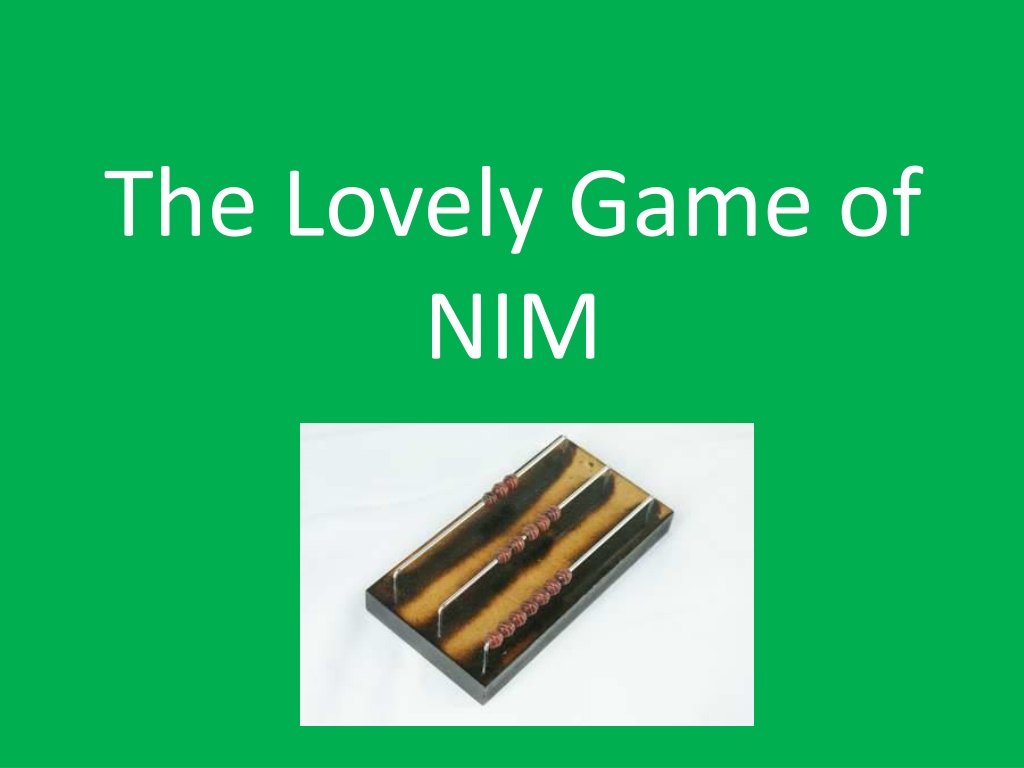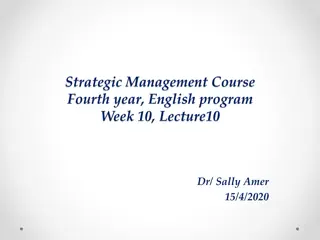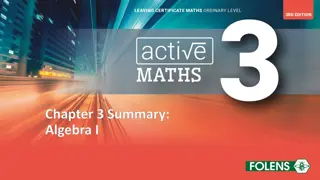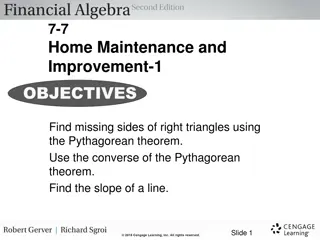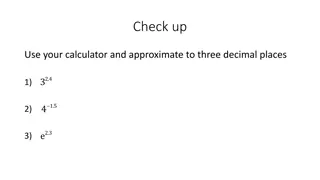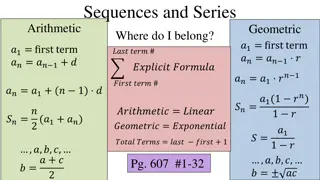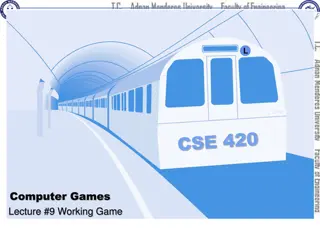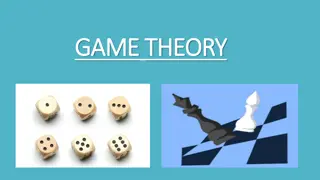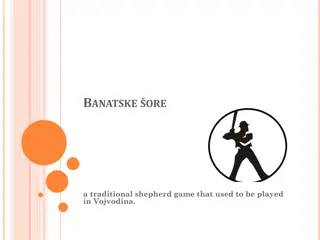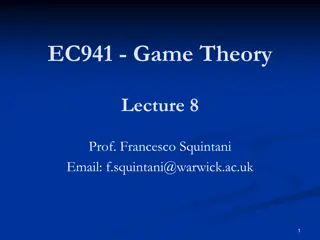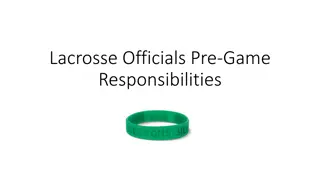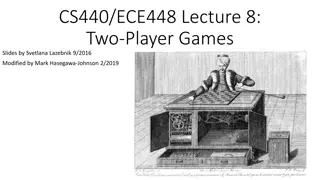The Lovely Game of NIM - Mathematically Engaging Strategy Game
Explore the classic NIM game and its variations to understand winning strategies, positional advantages, and rule modifications. Dive into mathematical inquiries, discuss optimal moves, and investigate the impact of different game settings on outcomes.
Download Presentation

Please find below an Image/Link to download the presentation.
The content on the website is provided AS IS for your information and personal use only. It may not be sold, licensed, or shared on other websites without obtaining consent from the author. Download presentation by click this link. If you encounter any issues during the download, it is possible that the publisher has removed the file from their server.
E N D
Presentation Transcript
Version 1 - Classic NIM You will need seven objects, such as counters or blocks. It is a game for two players. Place the 7 counters in a pile and decide who will go first. (In the next game, the other player will have the first turn.) Each player takes turns to take away either one or two counters. The player who takes the last counter wins. LINK TO NRICH LINK TO NRICH
What questions would a mathematician ask?
Tasks Describe a winning strategy Can you explain why this strategy works? Change one of the rules of the game and investigate it
More Detailed Prompts for Discussion Is it better to go first or second? What are good/bad positions to find yourself in? Can you describe a winning strategy? Can you explain why it works? What happens if you start the game with a different number of counters? If you are forced to go second, but you can choose the number of counters to start with, what would you do? What if you can take a different number of counters away? What if the player to remove the last counter(s) is the loser?
Version 2 - NIM 345 Make a row of 3 counters, a row of 4 and a row of 5. Two players each take turns to remove any number of counters from a particular row. The player left with the last counter is the loser (or winner, as agreed at the start). LINK TO NRICH LINK TO NRICH
What questions would a mathematician ask?
Prompts for Discussion Is it better to go first or second? What are good/bad positions to find yourself in? Can you describe a winning strategy? Can you explain why it works? What happens if you start the game with a different number of counters? What if you can take a different number of counters away? What if the player to remove the last counter(s) is the loser?
Version 3 - Multiple Pile NIM Write three numbers on three lines The two players take turns reducing one of the numbers by any amount they like The player who makes the last move loses
Example Game Start 3 2 1
Example Game Start 5 4 3
What questions would a mathematician ask?
Prompts for Discussion Can you discover a winning strategy with (3, 2, 1), if you are the first player? Can you explain your strategy in words? How do you know you are about to lose? What are good/bad positions to be in? Can you use the same strategy for (5, 4, 3)? What is the same, what is different?
Prompts for Discussion Can you discover a winning strategy with (5, 3, 1), if you are the first player? How do you know you are about to lose? What are good/bad positions to be in? Play the game with other numbers such as (7, 4, 2), (6, 5, 3) Can you come up with a general winning strategy? Why does it work?
Possible Rule Changes What happens if the winner is the one who makes the last move is the winner? What happens if you can only remove 1 or 2 numbers? What happens if you have 4 rows? Or 5 rows?
Alternate Example Game Player 1 2 3 1 Player 2 2 2 1 Player 1 2 2 0 Player 2 2 1 0 Player 1 0 1 0 Player 2 0 0 0 Start Loses! 5 3 1
Version 4 - Slide NIM Place a counter on each of the four coloured squares. Two players take turns to move any counter one, two or three spaces, until they reach the end of the track and are removed. No jumping is allowed. The winner (or loser as agreed) is the person left with sliding the last counter off the track. LINK TO NRICH LINK TO NRICH
What questions would a mathematician ask?
Prompts for Discussion Is it better to go first or second? What are good/bad positions to find yourself in? Can you describe a winning strategy? Can you explain why it works? What happens if you start the game with a different number of counters? What if you can take a different number of counters away? What if the player to remove the last counter(s) is the loser?
Version 5 - NIMIM Place twenty-five counters on the game board as shown. Players take turns to remove one or more counters that are side-by-side (no spaces between) on a straight line. The last player to take a counter is the loser Though complete analysis is too difficult, continuous scoring will help focus attention on early moves. (1 point for each counter removed, minus 5 for the last counter). Encourage the children to think backwards form the final move to discover helpful strategies towards the end of the game. LINK TO NRICH LINK TO NRICH
What questions would a mathematician ask?
Prompts for Discussion Is it better to go first or second? What are good/bad positions to find yourself in? Can you describe a winning strategy? Can you explain why it works? What happens if you start the game with a different number of counters? What if you can take a different number of counters away? What if the player to remove the last counter(s) is the loser?
Version 6 - Slippery Snail This is a game for two players. You will need a game board and four counters (or coins). If you are drawing it yourself, count the spots carefully. Place a counter on each star. Players take turns to move any counter, moving out towards the snail's tail. A counter can only be moved by sliding it ahead 1, 2 or 3 spots. Counters cannot jump on or pass each other. When a counter reaches the tail, it slides of and is out of the game. The winner is the player who slides the last counter off the snail LINK TO NRICH LINK TO NRICH
What questions would a mathematician ask?
Prompts for Discussion Is it better to go first or second? What are good/bad positions to find yourself in? Can you describe a winning strategy? Can you explain why it works? What happens if you start the game with a different number of counters? What if you can take a different number of counters away? What if the player to remove the last counter(s) is the loser?
